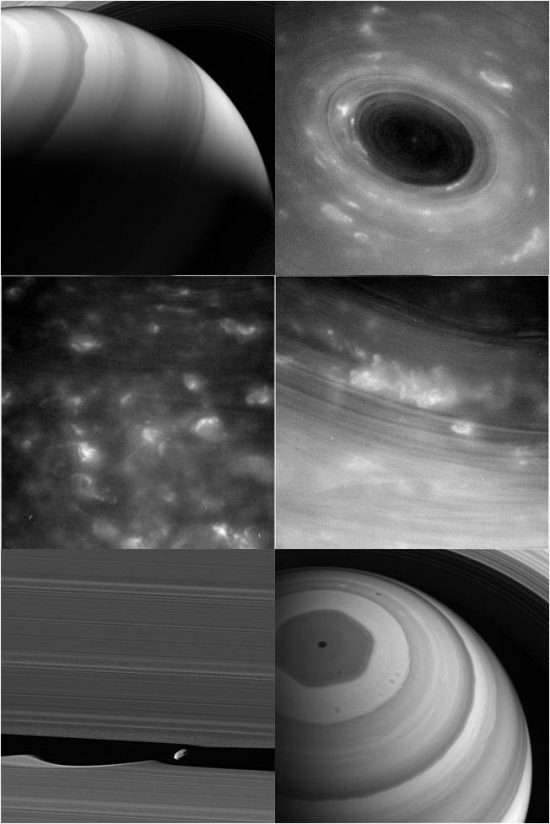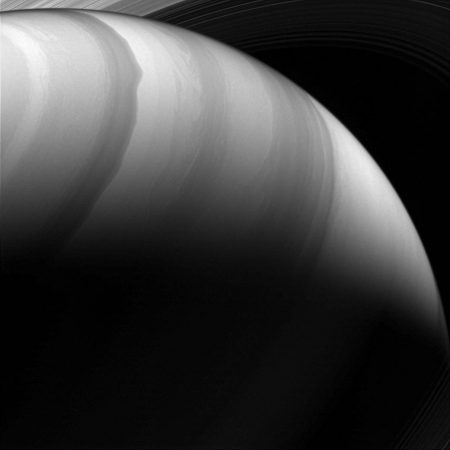April 28, 2017 – As NASA’s Jet Propulsion Laboratory reported the first of 22 orbits that will take the Saturn-orbiting Cassini through that planet’s ring system, a science team leader made the “irrevocable” statement. Jim Green, Director of the Planetary Sciences Division of NASA was remarking about the collective knowledge gained about the Saturnian system. Unprocessed images (some of which appear below) show details of Saturn’s atmosphere shot while the spacecraft navigated through a ring gap. The planet’s cloud tops were a mere 3,000 kilometers (1,900 miles) beneath it and the edge of the innermost ring was a mere 300 kilometers (190 miles) away.
Cassini was launched in 1997 and reached Saturn in 2004. The spacecraft is almost out of its maneuvering fuel and as a grand finale NASA has it flying between the rings of Saturn in a once a week orbit. In less than 22 weeks from now, on September 15th of this year, Cassini will rendezvous with Saturn and crash into the atmosphere ending its 20-year mission.
We often talk about how expensive these planetary missions are and the amount of money that goes into the robotic spacecraft, landers and rovers that NASA sends into the Solar System and beyond. But how many machines do we build that can survive a 20-year mission into the extreme environment of space while flawlessly executing instructions and delivering data over a distance of billions of kilometers.
Cassini is just one of these incredible robotic space explorers that have given back to scientists and the world tenfold more than expected. Think of another, Opportunity, one of the pair of rovers sent to Mars which just turned 13 years old. The original mission for the rover was 90 days. And now NASA scientists have sent the Martian rover on a new journey to explore another feature of the planet.
What Cassini has revealed to us in its 20 years is amazing details about the Saturnian system, a mini-Solar System of its own. Here are just some of things we have observed and learned from this robot:
- Before Cassini, we knew of 18 Saturnian moons. Now we know there are 62 and counting.
- Titan, the largest moon of Saturn, is a very cold version of Earth with lakes, rivers, channels, dunes, rain clouds, mountains, and volcanoes.
- The Huygens probe launched from Cassini has given us details about Titan’s atmosphere and surface that have produced hundreds of papers and articles.
- We have found propylene (stuff we turn into plastic containers) in Titan’s atmosphere.
- Enceladus, the small moon of Saturn that sends plumes of ice water into space has revealed itself to be an ocean world with hydrothermal vents spouting evidence of potential life from beneath its frozen surface.
- Cassini showed us that Saturn’s poles are home to enormous storm systems similar to hurricanes on Earth.
- The moons Dione, and Rhea, both small ocean worlds have revealed very thin atmospheres in which there are trace levels of oxygen.
- And although the Cassini mission has been at Saturn for 13 Earth years, the spacecraft has only observed less than two of Saturn’s years watching how seasonal changes have impacted the planet over that time.
- We now know that Saturn’s seasons which result from its 27-degree tilt from the solar plane (Earth’s tilt is a little over 23 degrees), provide a rich variety of changes that we could not have observed from Earth-based telescopes or even the Hubble. Cassini has shown us Saturn’s wintery northern hemisphere with its clear blue skies. In spring we have watched as aerosols turn the atmosphere a yellow-ochre. We have seen lightning bolts erupt from clouds and witnessed a storm bigger than Jupiter’s Great Red Spot warm the atmosphere 80 Celsius (144 Fahrenheit) degrees above the surroundings, and lasting for three Earth years before finally subsiding.
- We have studied Saturn’s rings, have found shepherd moons, that appear to keep the rings in position leaving gaps and icy trails through and along the edge of the ring debris.
And we are far from done yet because Cassini will continue to study the planet and the rings close up over the next few months until it finally says goodbye to 20 years of incredible scientific discovery.
What has been the cost of all of this?
- $1.4 billion U.S. for Cassini
- $704 million for mission operations
- $422 million for the rocket
- $54 million for tracking
That works out to $20 million per year for Cassini and just under $38 million for tracking and operations over two decades. Even the throwaway one-time cost of the rocket works out when amortized over the life of the mission to $21 million annually. That’s a lot of science for $79 million per year.




















